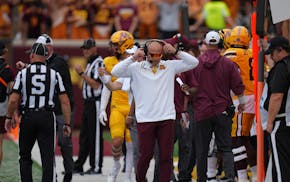This will not be an easy opinion piece to offer. It will go against decades of tradition, based on my belief that balance is required in our public sports commentary.
The Vikings were the golden boys when I started writing sports columns in Twin Cities dailies those many years ago. And, thus, the favored option was not to join in the adulation.
For instance, there was once this exchange with Remarkable Mike Lynn, my all-time favorite Vikings executive.
More quizzically than angrily, Lynn asked: "Ric-eey, what's your theory when writing about our Vikings?"
Response: "It is quite simple, sir. When you lose, I rip you. When you win, I rip the other team."
This was more a joke than a fact, by a ratio of 60-to-40.
As the local media has grown larger, the homerism here has gone from substantial to outrageous.
Zygi Wilf and the entire Wilf family are honored as being generous owners, even as seat licenses, new sponsorships and public funds took care of a gigantic share of the $1.15 billion spent for the U.S. Bank Stadium to serve as a Vikings profit center. Now, there's going to be a little tab for $280 million in maintenance in the years ahead, with no dollars publicly committed yet from the Wilf empire.
So when do we get to the Purple praise part?
Right now, reluctantly.
The most outstanding offseason in Vikings history came in 1967 and involved the departure of a quarterback, Fran Tarkenton. He was traded to the New York Giants, and Hal Bledsoe, Tommy Mason and a second-rounder were packaged to the Rams, and the Vikings landed these assets:
Alan Page, Bobby Grim, Clint Jones, Ron Yary (1968) and Ed White (1969).
The football boss, Jim Finks, also made a highly successful coaching change, accepting Norm Van Brocklin's resignation (with relief) and bringing in Bud Grant from the Winnipeg Blue Bombers.
The move of another high-profile quarterback in Kirk Cousins already has made this an outstanding offseason for the current Vikings, and we're still a few days from seeing what maneuvers will be made in a draft of considerable promise.
The reward for getting rid of Cousins is not draft choices, but rather saving tens of millions of dollars that will allow a future of much greater potential.
Throw in the fact the oft-injured pass rusher, Danielle Hunter, was also allowed to move on as a free agent and — once the dead money for Cousins and Hunter is accounted for in 2024 — the salary cap will no longer be an endless issue for roster building.
The masterful part of the Vikings' handling of the Cousins situation is that they kept acting as though they would like to keep him, even though common sense told us that was hogwash. Cousins, 36 when the season starts, got his money — a $50 million signing bonus and a potential $180 million over four years — from the moronic Falcons, and the Vikings didn't even have to say, "We have to move on. Six years of high mediocrity is plenty at those prices."
And this was definitely the year to make the move: After a 7-10 season, the Vikings already were at No. 11 in the first round, and a draft with four quarterbacks that carry a solid chance to be an upgrade over Cousins by the 2025 season.
Caleb Williams, Drake Maye, Jayden Daniels and J.J. McCarthy seem to be a rare group of quarterback potential. There is also Michael Penix Jr. (pretty good).
The moves made in free agency also have reflected generously on the leadership of Kwesi Adofo-Mensah, the young general manager, and Kevin O'Connell, the young head coach.
Knowing Hunter was gone, they brought in two pass rushers; Jonathan Greenard and Andrew Van Ginkel. And with Cousins gone, they brought in Sam Darnold as an adequate quarterback, holding forth as the rookie taken in the first round learns his trade.
And there was this absolute genius: The Vikings took advantage of the Packers' pay-cutting feud with running back Aaron Jones, 29, and signed him for the paltry fee of $7 million. A gentleman in my circle of NFL wisdom said this:
"When you watched the Packers offense in recent times and it looked bad, Jones was hurt and not playing. When you watched their offense and it looked very good, Jones was playing."
Note: Tarkenton returned in 1972 and the Vikings went to three Super Bowls in the next five years. That will not be repeated with Cousins.

Reusse: Murphy's return will be a fun time on the ice

Reusse: Gophers vs. Huskers and an 80th birthday on a fall Friday? Good day to be a homer again

Reusse: Bring on boos, but Gilgeous-Alexander is a deserving MVP

Reusse: A closer study of the Wolves at their absolute best reveals the value of Randle

